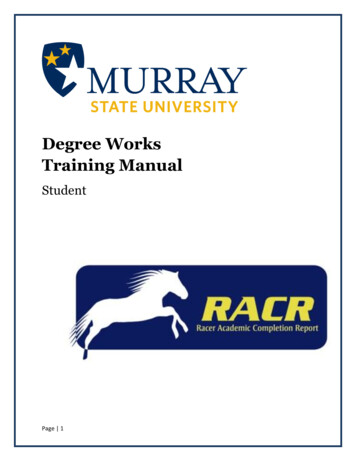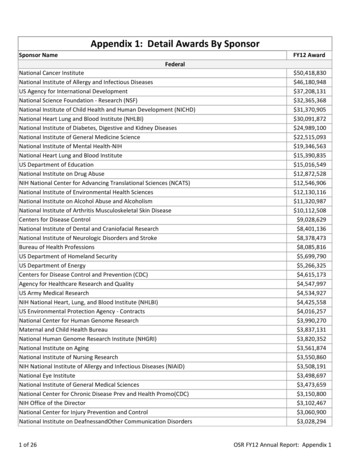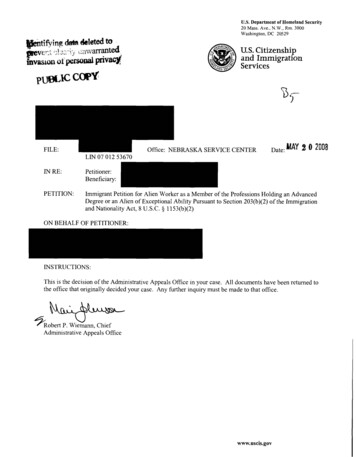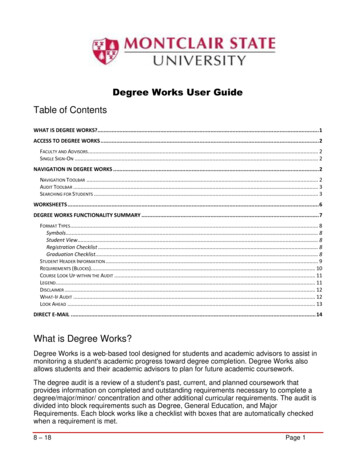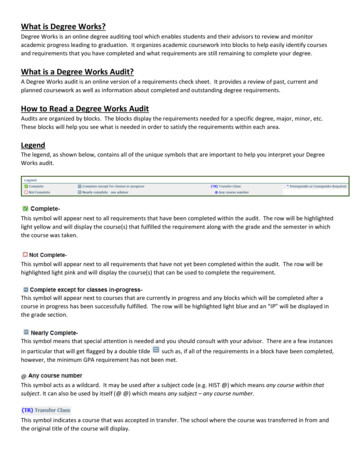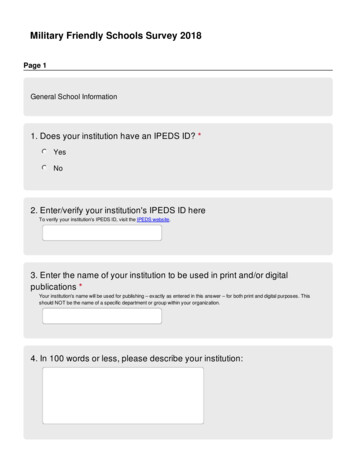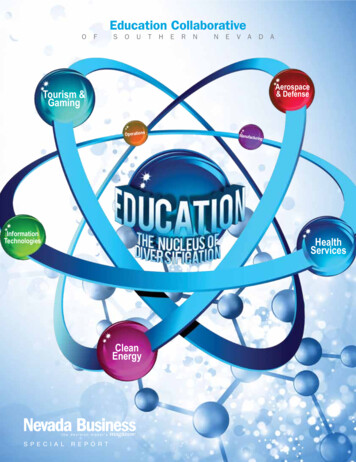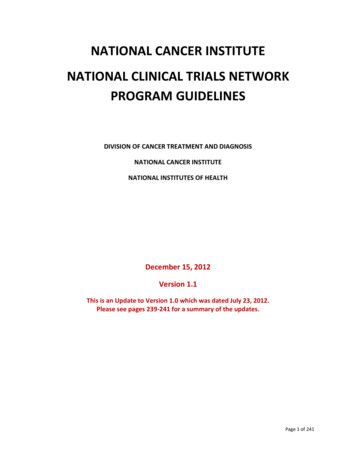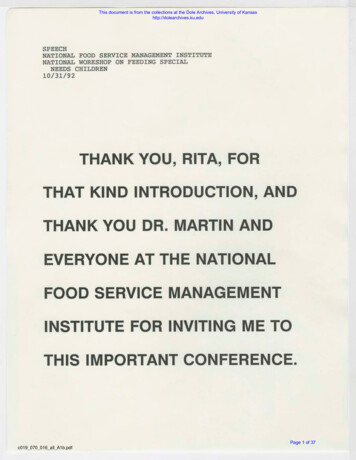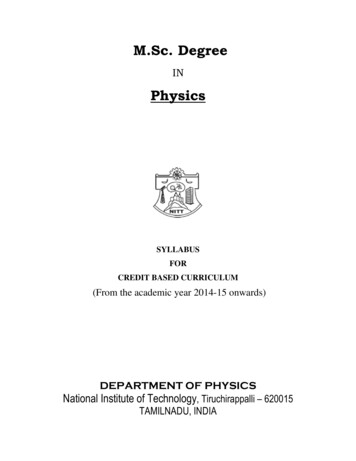
Transcription
M.Sc. DegreeINPhysicsSYLLABUSFORCREDIT BASED CURRICULUM(From the academic year 2014-15 onwards)DEPARTMENT OF PHYSICSNational Institute of Technology, Tiruchirappalli – 620015TAMILNADU, INDIA
M.Sc. (Physics)Department of PhysicsTHE INSTITUTEVisionTo provide valuable resources for industry and society through excellence in technicaleducation and research.Mission To offer state-of-the-art undergraduate, postgraduate and doctoral programmes. To generate new knowledge by engaging in cutting-edge research. To undertake collaborative projects with academia and industries. To develop human intellectual capability to its fullest potential.THE DEPARTMENTVision Provide a world class scientific platform for scientists and engineers.Mission Establish the department as a global player in Science and Technology. Excel in scientific R&D and consultancy. Create an environment for society aimed at knowledge enhancement.1
M.Sc. (Physics)Department of PhysicsCURRICULUMTotal minimum credits required for completing M.Sc. Programme in Physics is 66.SEMESTERCODEPH651PH653PH655PH657PH659COURSE OF STUDYMATHEMATICAL PHYSICS – ICLASSICAL MECHANICSQUANTUM MECHANICSELECTRONICSGENERAL PHYSICS LABORATORYELECTIVE – 1TOTAL 000P000C33330030300602317L3T0P0C8311IVCODECOURSE OF STUDYPH662 PROJECT WORK AND VIVA-VOCEELECTIVE – 4TOTAL CREDITS2T011000IIICOURSE OF STUDYSOLID STATE PHYSICSATOMIC AND MOLECULAR SPECTROSCOPYNUCLEAR AND PARTICLE PHYSICSNUMERICAL AND COMPUTATIONALMETHODSADVANCED PHYSICS LABORATORYELECTIVE – 3TOTAL CREDITSSEMESTERL333303IICOURSE OF STUDYMATHEMATICAL PHYSICS – IIELECTROMAGNETIC THEORYSTATISTICAL MECHANICSINSTRUMENTATIONELECTRONICS LABORATORYELECTIVE – 2TOTAL CREDITSSEMESTERCODEPH661PH663PH665PH667I
M.Sc. (Physics)LIST OF ELECTIVESDepartment of Physics*Odd SemesterPH611 DIGITAL SIGNAL AND IMAGE PROCESSINGPH613 BASICS OF ENGINEERING MATERIALSPH671 WAVEGUIDES AND MODERN OPTICSPH673 SOLAR PHOTOVOLTAIC TECHNOLOGYPH675 ADVANCED ELECTROMAGNETIC THEORYPH677 FIBER OPTIC SENSORSPH679 SENSORS AND TRANSDUCERSPH681 PHYSICS AND TECHNOLOGY OF THIN FILMSPH683 MAGNETISM AND SUPERCONDUCTING LEVITATIONPH685 MICRO-ELECTRO-MECHANICAL SYSTEMSEven SemesterPH610 ELECTRICAL, MAGNETIC AND OPTOELECTRONIC MATERIALSPH672 MICROPROCESSORSPH674 COMPUTER APPLICATIONS IN PHYSICSPH676 NON-DESTRUCTIVE TESTINGPH678 LASERS AND APPLICATIONSPH680 ADVANCED STATISTICAL METHODS AND PHASE TRANSITIONPH682 SEMICONDUCTOR PHYSICSPH684 NANOSCIENCE AND TECHNOLOGY & APPLICATIONS*Electives are not limited to the given list. Courses from other PG programmes can also bechosen as subjects of study. The courses will be offered based on convenience of thefaculty concerned.3
M.Sc. (Physics)Department of PhysicsI SEMESTERPH651 – MATHEMATICAL PHYSICS - IObjective: To introduce basic mathematical topics necessary to understand and appreciatevarious physical laws of nature.Unit – I: Vector AnalysisDefinition of vectors – scalar and vector product – triple products – gradient, divergence,curl – vector integration – Gauss’s theorem – Green’s theorem – Stoke’s theorem – Diracdelta function – Helmholtz theorem.Unit – II: Curved coordinates, TensorsOrthogonal coordinates – differential vector operators: gradient, divergence, curl – specialcoordinate systems: rectangular, spherical, cylindrical – tensors of rank two – contraction,direct product – quotient rule.Unit – III: Linear AlgebraDeterminants – matrices – inner product, direct product – orthogonal matrices – Eulerangles – symmetry properties – relation to tensors – Pauli matrices – eigenvalue equationand diagonalization – Cayley-Hamilton theorem – functions of matrices – hermitianmatrices.Unit – IV: Ordinary Differential EquationsFirst order equation – second order homogeneous equation – Wronskian – second solution– inhomogeneous equation – forced oscillation and resonance – power series method –Hermite and Legendre equations – Frobenius method – Bessel equation.Unit-V: ProbabilityDefinition – basic theorems – permutation and combination – method of counting –random variables – binomial and Poisson distributions – normal distribution – central limittheorem.Text Books1. G. B. Arfken and H.J. Weber, Mathematical Methods for Physicists, 5th edition,Academic Press (2001).2. E. Kreyszig, Advanced Engineering Mathematics, 8th edition, John Wiley & SonsInc. (1999).3. Mathematical Methods in the Physical Sciences, 3rd edition, Mary L. Boas, WileyIndia (2011).Reference Books1. L.A. Pipes and L.R. Harvill, Applied Mathematics for Engineers and Physicists,McGraw-Hill (1970).4
M.Sc. (Physics)Department of PhysicsOutcome: Students will be capable of handling variety of courses on mechanics andelectromagnetic theory.PH653 – CLASSICAL MECHANICSObjectives:1. To learn and use Newton’s laws of motion to solve advanced problems involvingthe dynamic motion of classical mechanical systems.2. To introduce differential calculus and other advanced mathematical techniquespertaining to the development of Lagrangian and Hamiltonian formulations ofclassical mechanics.3. To solve the dynamical problems using conservation laws.Unit – I: Lagrangian FormulationMechanics of a system of particles – constraints – Lagrangian equation of motion fromD'Alembert's and Hamilton's principles – conservation of linear momentum, energy andangular momentum – applications of the Lagrangian formalism.Unit – II: Central Force ProblemReduction to an one body problem – equation of motion and first integrals – onedimensional problems and classification of orbits – Kepler problem – scattering in a centralpotential – Rutherford formula – scattering cross section – transformation to laboratoryframes.Unit – III: Rigid Body and Oscillating SystemElements of rigid-body dynamics – Euler angles – symmetric top and applications – smalloscillations – normal mode analysis – normal modes of a linear tri-atomic molecule –forced oscillations – effect of dissipative forces on free and forced oscillations – dampeddriven pendulum.Unit – IV: Hamiltonian FormulationLegendre transformation – Hamiltonian equations of motion – cyclic coordinates – phasespace and Liouville's theorem – Poisson brackets.Unit – V: Special Theory of RelativityInternal frames – principle and postulate of relativity – Lorentz transformations – lengthcontraction, time dilation and the Doppler effect – velocity addition formula – four-vectornotation – energy-momentum – four-vector for a particle – relativistic invariance ofphysical laws.Text Books1. H. Goldstein, C. Poole and J. Safko, Classical Mechanics, 3nd edition, Addison &Wesley (2000).2. W. Greiner, Classical Mechanics, Springer-Verlag (2003).3. W. Greiner, Classical Mechanics – Point particles and Relativity, Springer (1989).5
M.Sc. (Physics)Department of PhysicsReference Books1. I.C. Percival and D. Richards, Introduction to Dynamics, Cambridge UniversityPress (1983).2. J.V. Jose and E.J. Saletan, Classical Dynamics: A Contemporary Approach,Cambridge University Press (1998).3. E.T. Whittaker, A Treatise on the Analytical Dynamics of Particles and RigidBodies, 4th edition, Cambridge University Press (1989).Outcome: Effective learning of items 1, 2 and 3 will enable the students to understand thecomplicated classical dynamical problems and find possible solutions for these problems.PH655 – QUANTUM MECHANICSObjectives:1. To introduce the mechanics of mater-waves necessary for uncovering the mysteriesof matter at atomic scale.2. To understand the spectrum of hydrogen.3. To introduce various approximate methods useful for more complex problems.Unit – I: Schrödinger EquationInadequacy of classical theory – de-Broglie hypothesis of matter waves – Heisenberg’suncertainty relation – Schrödinger’s wave equation – physical interpretation and conditionson wave function – eigenvalues and eigenfunctions – particle in a square-well potential –potential barrier – tunneling.Unit – II: Operators and EigenfunctionsLinear operator – orthogonal systems and Hilbert space – expansion in eigenfunctions –Hermitian operators – canonical commutation – commutations and uncertainty principle –state with minimum uncertainty.Unit – III: Solvable ProblemsHarmonic oscillator – operator method – Schrödinger equation for spherically symmetricpotentials – angular momentum operator – condition on solutions and eigenvalues –spherical harmonics – rigid rotor – radial equation of central potential – hydrogen atom –degenerate states.Unit – IV: Angular Momentum and SpinEigenvalues of angular momentum J – matrix representation of J – electron spin – Stern –Gerlach experiment – Zeeman effect – addition of angular momentum – Clebsh-Gordancoeffecients – identical particles with spin – Pauli exclusion principle.Unit – V: Approximation MethodsPerturbation theory for non-degenerate states – removal of degeneracy – Stark effect –variation method – WKB approximation – Bohr-Sommerfeld quantum condition –6
M.Sc. (Physics)Department of Physicspertubative solution for transition amplitude – selection rules – Fermi Golden rule –scattering of a particle by a potential.Text Books1. P.M. Mathews and K. Venkatesan, A Textbook of Quantum Mechanics, TataMcGraw-Hill (1976).2. J.L. Powell and B. Crasemann, Quantum Mechanics, Narosa Publishing House(1993).3. J.J. Sakurai, Modern Quantum Mechanics, Addison-Wesley (1999).4. Quantum Mechanics, Aruldhas, Prentice Hall of India (2006).Reference Books1. L.I. Schiff, Quantum Mechanics, McGraw-Hill (1968).2. D.J. Griffiths, Introduction to Quantum Mechanics, Pearson Education (2005).3. N. Zettili, Quantum Mechanics: Concepts and Applications, John Wiley (2009).4. L.D. Landau and E.M. Lifshitz, Quantum Mechanics (Non-relativistic Theory), 3rdedition, Elsevier (2011).Outcome: Intriguing probabilistic nature of matter at atomic scale will be understood.Students will be capable of handling courses like Statistical Mechanics, Solid StatePhysics, Spectroscopy and Nuclear Physics.PH 657 – ELECTRONICSObjective: To impart a diversified knowledge on circuit analysis, the semiconductordevices, FETs, operational amplifiers and digital circuits and their applications.Unit – I: Circuit Theorems and Special DiodesKirchoff’s laws for current and voltage – Thevenin’s and Norton’s theorems, superpositionand reciprocity theorems with examples – p-n junction diodes – Zener diode – tunneldiode – Schottky barrier diode – varactor diode-photodiode – solar cell – photodiodes andtransistors – light emitting diode – semiconductor laser – UJT – opto-couplers.Unit – II: Bipolar Transistor Amplifiers and FETsBiasing characteristics of junction transistors – analysis using re model-fixed bias-voltagedivider bias-emitter bias – direct coupled transistor amplifiers – single stage transistoramplifier – frequency response – feed back in amplifiers – effect of negative feedback inamplifiers – FETs – different types-low and high frequency FETs, frequency response ofFET – applicationsUnit-III: OscillatorsOscillator principle – oscillator types – frequency stability, RC oscillators – phase shiftoscillator – Wein bridge oscillator – LC tunable oscillators – limitations – multivibrators –monostable and astable – 555 IC timer – sine wave and triangular wave generation –crystal oscillators and their applications.7
M.Sc. (Physics)Department of PhysicsUnit – IV: Operational AmplifiersBasis of operational amplifier – characteristics – CMRR – inverting and non-invertingmodes- sum and difference amplifiers – integrating and differentiating circuits – feedbacktypes – current to voltage (ICVS) and voltage to current (VCIS) conversion –– op-ampapplication – instrumentation amplifiers – low pass and high pass active filters.Unit – V: Digital CircuitsLogic gates: De Morgan’s law, binary adder, comparators, decoders, multiplexers. Flipflops: RS flip-flop, JK flip- flop, JK master-slave flip-flops, T flip-flop, D flip-flop. Shiftregisters – synchronous and asynchronous counters – registers – A/D and D/A conversion.Text Books1. J. Milman and C.C. Halkias, Electronic Devices and Circuits, McGraw-Hill (1981).2. Albert Malvino, David J Bates, Electronics Principles, Tata McGraw-Hill (2007).3. R.J. Higgins, Electronics with Digital and Analogue Integrated Circuits, PrenticeHall (1983).Reference Books1. R. L. Boylsted and L. Nashelsky, Electronic Device and Circuits, PearsonEducation (2003).2. C.L Wadhwa, Network Analysis and Synthesis, New Age International Publishers,(2007).3. G.B. Calyton, Operation Amplifiers, ELBS (1980).Outcome: On successful completion of this course, students would be able i) tounderstand the construction, working function, characteristics and applications of varioussemiconductor devices and ii) to describe the design and applications of various digitalcircuits.PH659 – GENERAL PHYSICS LABORATORYObjective: To introduce the basic concepts of physics through hands on experience andimpart experimental skill to students.List of Experiments1. Hall Effect in Semiconductor2. Non-Destructive Testing – Ultrasonics3. Two Probe Method for Resistivity Measurement4. Wavelength Measurement of Laser using Diffraction Grating5. Numerical Aperture of an Optical Fiber6.Electron Spin Resonance8
M.Sc. (Physics)Department of Physics7. Specific Heat Capacity of Solids8.Half Shade Polarimeter and Strain Viewer9. Michelson Interferometer10. Acoustic Diffraction11. Vacuum Pumps – Low Pressure Measurement and Determination of Pumping Speed12. Zeeman effect13. Hydrogen Spectra and Rydberg Constant14. Forbe’s Method – Thermal Conductivity of Metal15. Kundt’s Tube16. Solar-Cell Characteristics17. Magnetic Susceptibility of Liquids – Quincke’s Method18. Curie Temperature of Magnetic Materials19. Dielectric Constant and Curie Temperature of Ferroelectric Ceramics20. Hysteresis (B – H Curve)21. Helmholtz Galvanometer22. Faraday Effect23. Millikan Oil Drop Experiment – e/m of Electron24. Determination of Planck’s Constant25. Cornu’s Method – Determination of Elastic Constants of Transparent MaterialsText Books1. General Physics Laboratory Manual, Department of Physics, NITT.Reference Books1. R.A. Dunlap, Experimental Physics: Modern Methods, Oxford University Press,New Delhi (1988).2. E.V. Smith, Manual for Experiments in Applied Physics, Butterworths (1970).3. D. Malacara (ed.), Methods of Experimental Physics, Series of Volumes, AcademicPress Inc. (1988).Outcome: The student will be able to understand the fundamental physics behind manyscientific discoveries through hands on experience.* * * * *9
M.Sc. (Physics)Department of PhysicsII SEMESTERPH652 – MATHEMATICAL PHYSICS - IIObjective: To introduce basic mathematical topics necessary to understand and appreciatevarious physical laws of nature.Unit – I: Infinite SeriesFundamental concepts – convergence test: Cauchy’s ratio test, Gauss’s test – alternatingseries – algebra of series – Taylor expansion – Binomial theorem – power series –asymptotic series – Stirling’s formula.Unit – II: Complex AnalysisFunctions of complex variable – derivative and Cauchy-Riemann equation – line integral –Cauchy's integral theorem – Cauchy’s integral formula – Laurent series – Cauchy's residuetheorem – poles – evaluation of residues – evaluation of definite integrals.Unit – III: Integral TransformsFourier series – convergence – functions of any period – complex form – Fourier integraltheorem – Fourier transform – Dirac delta function – Laplace transform – convolutiontheorem – transform of derivates – application to differential equation.Unit – IV: Group TheoryIntroduction to group theory – generators of continuous groups – rotation groups andangular momentum – SU(2)-SO(3) homomorphisms – orbital angular momentum –discrete groups – character table – irreducible representation.Unit – V: Partial Differential EquationsVibrating string – d’Alembert’s solution of wave equation – diffusion equation – solutionby Fourier series – Poisson equation – method of separation of variables – Green’sfunction method.Text Books1. G. B. Arfken and H.J. Weber, Mathematical Methods for Physicists, 5th edition,Academic Press (2001).2. E. Kreyszig, Advanced Engineering Mathematics, 8th edition, John Wiley & SonsInc. (1999).3. Mathematical Methods in the Physical Sciences, 3rd edition, Mary L. Boas, WileyIndia (2011).Reference Books1. L.A. Pipes and L.R. Harvill, Applied Mathematics for Engineers and Physicists,McGraw-Hill (1970).Outcome: Students will acquire enough mathematical skills to handle variety of equations,appear in various physical situations, with ease.10
M.Sc. (Physics)Department of PhysicsPH654 – ELECTROMAGNETIC THEORYObjective: To understand the nature of electric and magnetic force fields and the intricateconnection between them.Unit – I: ElectrostaticsElectric field – divergence and curl – electric potential – conductors – Laplace equation(1D, 2D and 3D) – uniqueness theorem – separation of variables: Cartesian and sphericalcoordinates – field of an electric dipole – polarization – Gauss’s law in dielectrics – lineardielectrics – energy density – boundary value problems.Unit – II: MagnetostaticsLorentz force – magnetic induction – electric current – equation of continuity – Biot-Savartlaw – magnetic potential – magnetization – Ampere’s law in magnetized material – energydensity – linear and nonlinear media.Unit – III: Maxwell’s EquationsFaraday’s law – generalization of Ampere’s law – Maxwell’s equations – boundaryconditions – scalar and vector potentials – gauge invariance – electromagnetic energy –Poynting’s theorem.Unit – IV: Electromagnetic WavesElectromagnetic wave equation (without source) – solution of 3D wave equation –propagation of EM waves in non-conducting media – waves in conducting media –polarization.Unit – V: Waves in Bounded RegionReflection and refraction at the boundary of non-conducting media – Fresnel’s coefficients– Brewster’s angle and critical angle – reflection from a conducting plane – wave guide –TE and TM waves – rectangular wave guide.Text Books1. D. J. Griffiths, Introduction to Electrodynamics, Prentice Hall of India, 3nd edition(1999).2. J.R. Reitz., F.J. Milford and R.W. Christy, Foundations of Electromagnetic Theory,4th edition, Pearson (2010).Reference Books1. J.D. Jackson, Classical Electrodynamics, Wiley-India, 3rd edition (2011).2. E.C. Jordon and K.G. Balmain, Electromagnetic Waves and Radiating Systems, 2ndedition, Prentice Hall of India (1998).3. W. Greiner, Classical Electrodynamics, 3rd edition, Springer (2010).4. L.D. Landau and E.M. Lifshitz, Electrodynamics of Continuous Media, 2nd edition,Elsevier (2008).11
M.Sc. (Physics)Department of PhysicsOutcome: Electromagnetic nature of radiation and its propagation in media will beunderstood.PH656 – STATISTICAL MECHANICSObjectives:1. To learn the connection between macroscopic and microscopic state of a system oflarge number of particles.2. To understand thermal equilibrium of a system in statistical sense.Unit – I: ThermodynamicsIdeal gas law – exact differentials – first law, internal energy, heat capacity – second law,Carnot’s cycle, Carnot’s theorem, absolute temperature – Clausius theorem, entropy –thermodynamic potentials, Maxwell’s relations – chemical potential – third law.Unit – II: Theory of EnsemblesPostulates: phase space, microstates, density of states, ensemble average – Liouville’stheorem – microcanonical ensemble – quantum phase space – canonical ensemble –partition function (N particle) – ideal gas law – grand canonical ensemble.Unit – III: Maxwell-Boltzmann StatisticsBoltzmann system (identical, distinguishable particles) – Maxwell-Boltzmann distribution– Lagrange’s multipliers – partition function (single particle) – thermodynamics of gases –equipartition theorem – paramagnetic susceptibility.Unit – IV: Bose-Einstein StatisticsPrinciple of indistinguishability – Bosons – Bose-Einstein distribution – Planck’s law ofradiation – Stefan’s law – Einstein model of phonons (semi-classical) – Debye’s theory ofheat capacity of solids.Unit – V: Fermi-Dirac StatisticsFermions – Fermi-Dirac distribution – Fermi energy – electron gas in metals – thermionicemission – Pauli paramagnetism.Text Books1. M.W. Zeemansky and R.H. Dittman, Heat and Thermodynamics, 8th edition, McGraw Hill (2011).2. K. Haung, Statistical Mechanics, 2nd edition, Wiley India (2010).3. F.W. Sears and G.L. Salinger, Thermodynamics, Kinetic Theory and StatisticalThermodynamics, 3rd edition, Narosa Publishing House (1998).Reference Books1. Enrico Fermi, Thermodynamics, Dover (1956).2. R.K. Pathria and Paul D. Beale, Statistical Mechanics, 3rd edition, Academic Press(2011).12
M.Sc. (Physics)Department of Physics3. F. Reif, Fundamentals of Statistical and Thermal Physics, International Studentsedition, Tata McGraw-Hill (1988).4. S.J. Blundell and K.M. Blundell, Concepts in Thermal Physics, Oxford UniversityPress (2006).5. L.D. Landau and E.M. Lifshitz, Statistical Physics – Part I, 3rd edition, Elsevier(2010).Outcome: Students will be able to understand various properties of matter and radiation inthermal equilibrium through appropriate statistics. Students will be prepared to understandSolid State Physics.PH658 – INSTRUMENTATIONObjectives:1. Students will study the major characteristics of measurement systems and errorsinvolved in them.2. Students will gain an understanding related to production and measurement of lowtemperatures and high pressure.3. Student will read various spectroscopic techniques and detectors.Unit – I: Generalized Characteristics of InstrumentsStatic characteristics: accuracy, precision, repeatability, reproducibility, resolution,sensitivity, linearity, drift, span, range. Dynamic characteristics: transfer function , zeroorder instruments, first order instruments – step, ramp, frequency responses – second orderinstruments – step-ramp response – dead time elements. Types of Errors: gross, systematic,random.Unit – II: Vacuum SystemsPrinciple and operation of various pumps: rotary, diffiusion, sorption, turbomolecular,ionisation and cryopumping. Gauges: McLeod, diaphragm, thermocouple, pirani, penning,ionisation and hot and cold cathodes – design of high vacuum systems – high pressure cells– measurements at high pressures.Unit – III: Thermal SystemsTemperature scales – liquefaction of gases, achieving low temperature – design ofcryostats. High temperature furnaces: resistance, induction and arc furnaces – hightemperature measurements – pyrometers – total and selective radiation pyrometers –optical pyrometer.Unit – IV: Detectors and SpectroscopyDetectors: pyroelectric, thermoelectric, photoconducting, photoelectric, photomultiplier,scintillation types of detectors, photon counters. Spectroscopy: principles of atomicabsorption spectroscopy – instrumentation – single and double beam spectrometers –theoryand components of nuclear quadrupole resonance technique – applications.13
M.Sc. (Physics)Department of PhysicsUnit – V: Electronics and Experimental MethodsError analysis: linear and nonlinear curve fitting, chi-square test. Signal conditioning:impedance matching, filtering, noise reduction, shielding and grounding, lock-in detector,box-car integrator.Text Books1. A.K. Sawhney and Puneet Sawhney, A Course in Mechanical Measurement andInstrumentation, DhanpatRai&Sons, New Delhi 2000.2. Dennis Roddy and John Coolen, Electonic communication, 4th edition, PHI privateLtd., (1999). (Unit – II)3. C.S. Rangan, G.R. Sharma and V.S.V. Mani, Instrumentation Devices andSystems, Tata McGraw-Hill (1983).4. H.H. Willard, L.L. Merrit and John A. Dean, Instrumental Methods of Analysis, 6thedition, CBS Publishers & Distributors (1986).Reference Books1. D.V.S. Murty, Transducers and Instrumentation, Prentice – Hall of India (P) Ltd.,New Delhi (1995).2. Ernest O. Doebelin, Measurement System Applications and Design, McGraw HillInternational Book Company, Singapore (1983).Outcomes:1. To fully appreciate the various techniques involved in production of vacuum, lowtemperatures which will benefit them to handle various instruments in a better way.2. To really understand the characteristics of instruments and analysis of errors willhelp them in interpreting the obtained data more efficiently.PH660 – ELECTRONICS LABORATORYObjective: To introduce the various concepts of basic electronics and circuits throughhands on experience.List of Experiments1. Solving Simultaneous Equations2. Voltage Controlled Oscillator3. Op-Amp Arithmetic Operations4. Op-Amp Square, Ramp Generator and Wien Bridge Oscillator5. Op-Amp Precision Full Wave Rectifier6. Multiplexer and De-multiplexer7. Regulated Power Supply using IC 72314
M.Sc. (Physics)Department of Physics8. UJT-Characteristics of Relaxation Oscillator9. Logarithmic and Anti-logarithmic Amplifier10. Phase Shift Oscillator11. Astable and monostable Multivibrator using IC55512. Combinational Logic Circuit Design13. IC 555 timer – Schmitt Trigger14. Wien’s Bridge oscillator using operational amplifier15. Characteristics of Photo Diode, Photo Transistor, LDR, LED16. Series and Parallel Resonant Circuits17. Silicon Diode as a Temperature Sensor18. RC Coupled CE amplifier – Two stages with feedback – Frequency response andvoltage gain19. Push-pull amplifier using complementary – symmetry transistors power gain andfrequency response.20. Active filters – low pass and high pass-first and second order frequency responseand roll off rate.Text Books1. Electronics Laboratory Manual, Department of Physics, NITT.Reference Books1. B.K. Jones, Electronics for Experimentation and Research, Prentice-Hall (1986).2. P.B. Zbar, A.P. Malvino and M.A. Miller, Basic Electronics: A Text-Lab Manual,Tata Mc-Graw Hill, New Delhi (1994).Outcome: The student will be able to understand the fundamental physics behindelectronic circuits used in many modern devices through hands on experience.* * * * *15
M.Sc. (Physics)Department of PhysicsIII SEMESTERPH661 – SOLID STATE PHYSICSObjective: Students will have an appreciation on the physics and properties of differenttypes of materials such as conductors, semiconductors, dielectric, magnetic andsuperconducting.Unit – I: IntroductionSolids – crystalline and amorphous – crystal structure and symmetries – reciprocal lattice –defects and dislocations – Brillouine Zone – types of bonds: van der Waals, covalent, ionicand metallic – atomic scattering factor – geometric structure factor – electrons in aperiodicpotential – X-ray diffraction – liquid crystals.Unit – II: Conductors, Semicoductors and DielectricsConductors: Free electron theory – classical and quantum theory, band theory of solids –effective mass of electron – Kronig-Penny model – Bloch theorem – Hall effect –thermopower. Semiconductors: Types – carrier and Fermi level statistics for intrinsic andextrinsic semiconductors – electrical conductivity. Dielectrics: Types of polarization –frequency dependence of polarization – local electric field – dielectric constant andpolarizability – Clausius-Mossotti equation, piezo and ferroelctricity.Unit – III: Transport and Thermodynamic StudiesLattice vibrations – concept and momentum of phonons – vibrations of mono and diatomic lattices, heat capacity – Einstein and Debye models - Dulong and Petit’s law –Weidemann-Franz law – electronic heat capacity – experimental heat capacity of metals –resistivity – residual resistivity ratio – experimental electrical resistivity of metals –Matthiessen’s rule – Magnetoresistance – Giant and colossal magnetoresistance.Unit – IV: MagnetismMagnetic terminologies – types of magnetism – dia, para, ferro, ferri and antiferromagnetism – Hund’s rules – Curie-Weiss law – Langevin’s classical and quantumtheories of dia and para magnetism –Weiss theory of ferromagnetism – Heisenberg modelof exchange interaction – concept of domain and hysteresis – antiferro and ferrimagnetism– theories.Unit – V: SuperconductivitySuperconductivity – Meissner and isotope effect – thermodynamical and optical properties– supercurrents and penetration depth – London’s equations – BCS model conventional –unconventional – critical field – types of superconductors – metal-to-insulator transition –flux quantization – vortex lattice – high Tc superconductors – Josephson Junctions – ACand DC – superfluidity.Text Books1. Charles Kittel, Introduction to Solid State Physics, Wiley Eastern, 5th edition,(1983).16
M.Sc. (Physics)Department of Physics2. T.H.K. Barron and G.K. White, Heat capacity and Thermal Expansion at LowTemperatures, Kluwer Academic/Plenum Publishers, New York (1999).3. N.W. Ashcroft and N.D. Mermin, Solid State Physics, Cengage Learning (2010).4. Ali Omar, Elementary Solid State Physics, Pearson Education India (1999).5. J.S. Blakemore, Solid State Physics, 2nd edition, Cambridge University Press(1974).Reference Books1. B.S. Saxena, R.C. Gupta, P.N.Saxena, Fundamentals of solid state physics, PragatiPrakashan, 7th edition (1999).2. A.J. Dekker, Solid State Physics, Prentice Hall of India (1971).3. Helmut Kronmüller, Stuart Parkin, Handbook of Magnetism and AdvancedMagnetic Materials, Wiley (2007)4. Laurent-Patrick Lévy. Magnetism and superconductivity , Springer (2000).Outcome: Grasping the significance of transport and thermodynamic properties ofmaterials will enable students to understand the basics in physics of condensed matter.PH663 – ATOMIC AND MOLECULAR SPECTROSCOPYObjective: To understand in detail the structure of atoms and molecules.Unit – I: Atomic SpectraQuantum states of electron in atoms – hydrogen atom spectrum – electron spin – SternGerlach Experiment – spin-orbit interaction – Lande interval rule – two electron systems –LS-JJ coupling schemes – fine structure – spectroscopic terms and selection rules –hyperfine structure – exchange symmetry of wave function – Pauli's exclusion principle –periodic table.Unit – II: Atoms in External Fields and Resonance SpectroscopyZeeman and Paschen Back Effect of one and two electron systems – selection rules –
M.Sc. (Physics) Department of Physics 7 pertubative solution for transition amplitude - selection rules - Fermi Golden rule - scattering of a particle by a potential. Text Books 1. P.M. Mathews and K. Venkatesan, A Textbook of Quantum Mechanics, Tata McGraw-Hill (1976). 2.


